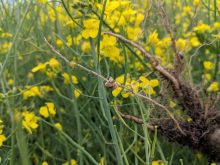The discussion around seed royalty is now official. The question is not, “Will we have a seed royalty?” The question is, “Which system is going to be implemented?” The options have been defined and the choice is between two payment plans, which will likely boil down to one: EPR, or end point royalty, a charge on each tonne of grain delivered, paid to the plant breeder. The question that farmers ask, “Is the age-old right of farmers to save seed going to be lost?” is irrelevant. This change will happen.
Read Also

Claas brings 1000 Series SP forage harvesters to Canada
In mid-August, Claas unveiled its new line of Jaguar forage harvesters at an event in Visalia, California, deep in the heart of that state’s dairy region.
I am a pragmatist. The seed industry wants more money. What do producers want in return for this investment? What should we negotiate?
As a seed grower I have a list of recommendations that would benefit the farmers and the process.
Better data
My first recommendation is better data. A significant share of the money collected for varieties needs to be reinvested in varietal testing to allow producers to more easily compare varieties before buying seed.
The current model of variety testing is woefully inadequate, which is why most of us have invested in a few varieties that looked good on paper, but were awful in the field. While better data cannot replace real-life field experience, the intent of testing is to provide a better platform to choose. We need an independent, standardized process, replicated, producing transparent results that test varieties for agronomy, disease, seed quality and even end-user functionality. We need head-to-head data, annual data, averaging data, by plot and by cumulative results.
This testing must be performed independently. The costs could be shared proportionately, to ensure small players have access to the system.
And, if you are collecting EPR, your varieties must be in the tests.
Conflict of interest
Who decides how publicly funded varieties are awarded to commercial companies? With more money at stake the potential for conflict of interest increases. Choosing a process to decide how varieties are awarded is key. I suggest that a committee include non-farmer professionals, such as lawyers, accountants, and conflict-of-interest authorities, to ensure the process is accountable and as transparent as possible.
Better still would be to take the Crown corporation rote with public institutions, turning them into companies with shareholders. The structure of LIMAGRAIN, the most successful seed house in the world which is a farmer-owned co-operative, is worthy of consideration. With LIMAGRAIN if you are no longer farming you cannot own shares, a novel concept indeed. This allows the future of the genetics to remain in the hands of those, who for the most part, have invested in the intellectual property for years.
Tax credits
An EPR is an investment in research. Producers must be allowed tax credits, just as any corporation investing in research.
Matching contributions
The new system should have matching contributions from both federal and provincial governments. Setting a matching contribution should help to ensure the government has a vested interest in assuring value. The requirement for a matching contribution must be airtight, tied directly to farmers, contributions, and not something governments can easily lower in the future.
Higher costs, higher value
If we are going to pay more for seed, I believe we should get more in return. Better data, a transparent and accountable process of management of the intellectual property, tax credits and government support. And we need better seed.
Farmers need to negotiate a fair deal, a return on the investment which validates the increased cost that is coming.
We must acknowledge that global trade patterns are changing rapidly. Canada must compete with an increasingly competitive world. There are countries where farmers do not pay for intellectual property, pay less for every input they use, and are more geographically central to markets. This fact must never be far from those who seek to add another straw to the Prairie camels’ packs.
Vicki Dutton is a grain trader with ADM Agri-Industries and a grain and cattle producer.















